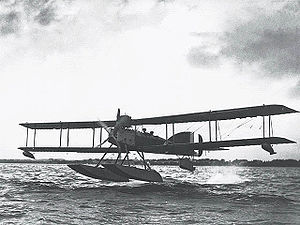Short Type 184 Video - Picture

|
|
Short Type 184
Type 184

Role: Scout / Torpedo bomber
Manufacturer: Short Brothers
Designed by: Horace Short
First flight: 1915
Introduced: 1915
Retired: 1933 (Estonia)
Primary users: Royal Naval Air Service
Royal Flying Corps
Hellenic Air Force
Estonian Air Force
Number built: 936
Variants: Mann Egerton Type B

Picture - Short Type 184 from FlightGlobal Collection
The Short Type 184 was a British two-seat reconnaissance, bombing and torpedo carrying folder seaplane designed by Short Brothers.
History
An urgent requirement by the British Admiralty for a torpedo-carrying seaplane was met by a design by Horace Short of Short Brothers, Rochester, England.
The first aircraft flew in early 1915 and 936 aircraft were built by ten different British aircraft companies(see list below), making it the most successful of Shorts' pre-World War II aircraft.
In August 1915, a Short 184 of piloted by Flight Commander Charles H. K. Edmonds from HMS Ben-my-Chree operating in the Aegean became the first aircraft in the world to attack an enemy ship with an air-launched torpedo.
However, on 17 August 1915, another Turkish ship was sunk by a torpedo of whose origin there can be no doubt. On this occasion Flight Commander C H Edmonds, flying a Short 184, torpedoed a Turkish steamer a few miles north of the Dardanelles. His formation colleague, Flt Lt G B Dacre, was forced to land on the water owing to engine trouble but, seeing an enemy tug close by, taxied up to it and released his torpedo. The tug blew up and sank. Thereafter Dacre was able to take off and return to the Ben-My-Chree..
Flt Lt Dacre later became Air Commodore and was appointed twice as Air Officer Commanding No. 1 School of Technical Training. His widow, Elizabeth Dacre (who had been a distinguished Group Officer in the WAAF), donated his dress sword to the Air Cadet Corps.
Despite early successes in sinking ships the 184s were mainly used for Bombing and Reconnaissance. A Short 184, aircraft number 8359, was the only aircraft to take part in the Battle of Jutland. The pilot on that occasion was Flt Lt Frederick Rutland (who became known ever after as “Rutland of Jutland”).
A landplane version of the S.184 was also sold to the Royal Flying Corps as the Short Bomber.
The aircraft served in most theatres of war, e.g. in the Dardanelles campaign and as far afield as Mesopotamia, and continued in service into the 1920s.
On 9 May 1916, a Short 184 seaplane, "using a bombsight developed by Bourdillon and Tizard, hit a target with a 500 pound bomb from a height of 4,000 feet."
In 2010, the Estonian Maritime Museum announced that they had ordered a stationary replica of the plane to be built for fitting into one of their historic seaplane hangars. However, the main designer was killed in a glider crash on the 11th of July of the same year. The future of the project is therefore unknown.
Operators
Canada Chile
Chilean Navy operated six aircraft 1919-33
Estonia
Estonian Air Force operated six aircraft 1919-33
Greece
Hellenic Air Force
United Kingdom
Royal Naval Air Service
Newhaven Seaplane Base
Royal Flying Corps
Royal Air Force
No. 202 Squadron RAF (1920-1921)
No. 219 Squadron RAF (1918-1920)
No. 229 Squadron RAF (1918-1919)
No. 230 Squadron RAF (1918-1919)
No. 233 Squadron RAF (1918-1919)
No. 234 Squadron RAF (1918-1919)
No. 235 Squadron RAF (1918-1919)
No. 237 Squadron RAF (1918-1919)
No. 238 Squadron RAF (1918-1919)
No. 239 Squadron RAF (1918-1919)
No. 240 Squadron RAF (1918-1919)
No. 241 Squadron RAF (1918-1919)
No. 242 Squadron RAF (1918-1919)
No. 243 Squadron RAF (1918-1919)
No. 245 Squadron RAF (1918-1919)
No. 246 Squadron RAF (1918-1919)
No. 248 Squadron RAF (1918-1919)
No. 249 Squadron RAF (1918-1919)
No. 252 Squadron RAF (1918-1919)
No. 253 Squadron RAF (1918-1919)
No. 263 Squadron RAF (1918-1919)
No. 264 Squadron RAF (1918-1919)
No. 265 Squadron RAF (1918-1919)
No. 266 Squadron RAF (1918-1919)
No. 267 Squadron RAF (1918-1921)
No. 268 Squadron RAF (1918-1919)
No. 269 Squadron RAF (1918-1919)
No. 270 Squadron RAF (1919-1919)
No. 271 Squadron RAF (1918-1918)
Specifications
General characteristics
Crew: 2
Length: 40 ft 7 in (12.38 m)
Wingspan: 63 ft 6in (19.36 m)
Height: 13 ft 6 in (4.11 m)
Wing area: 688 ft˛ (63.9 m˛)
Empty weight: 3,703 lb (1,680 kg)
Loaded weight: lb (kg)
Max takeoff weight: 5,363 lb (2,433 kg)
Powerplant: 1x— Sunbeam Gurkha (74 units), Sunbeam Maori, 260 hp (194 kW)
Performance
Maximum speed: 88 mph (142 km/h)
Service ceiling: 9,000 ft (2,745 m)
Endurance: 2ľ hrs
Armament
1 x— .303 in (7.7 mm) Lewis Gun in rear cockpit
1 x— 14 in (356 mm) torpedo or up to 520 lb (236 kg) of bombs
Manufacturers
Source: Barnes and James
Related development
Mann Egerton Type B
Short Bomber
Comparable aircraft
Wight Converted Seaplane
Bibliography
Gerdessen, F. (April - July 1982). "Estonian Air Power 1918 - 1945". Air Enthusiast (No 18): pp 61-76. ISSN 0143-5450.
Short Type 184 Pictures
Living Warbirds: The best warbirds DVD series.
Source: WikiPedia